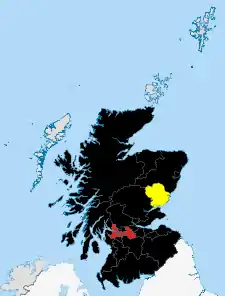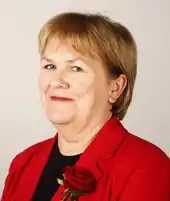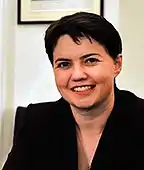2012 Scottish local elections
The 2012 Scottish local elections, were held on 3 May, in all 32 local authorities. The Scottish National Party (SNP) overtook Labour to win the highest share of the vote, and retained and strengthened its position as the party with most councillors. Labour also made gains, while the Liberal Democrats experienced meltdown, falling behind the Conservatives. For the first time since the introduction of the Single Transferable Vote system, the SNP won majority control of 2 councils, from no overall control. Labour also won majority control of 2 councils from no overall control, while retaining majority control over 2 councils.
| |||||||||||||||||||||||||||||||||||||||||||||||||||||||||||||||||
All 1,223 seats to 32 Scottish councils | |||||||||||||||||||||||||||||||||||||||||||||||||||||||||||||||||
|---|---|---|---|---|---|---|---|---|---|---|---|---|---|---|---|---|---|---|---|---|---|---|---|---|---|---|---|---|---|---|---|---|---|---|---|---|---|---|---|---|---|---|---|---|---|---|---|---|---|---|---|---|---|---|---|---|---|---|---|---|---|---|---|---|---|
| Turnout | 39.6% ( | ||||||||||||||||||||||||||||||||||||||||||||||||||||||||||||||||
| |||||||||||||||||||||||||||||||||||||||||||||||||||||||||||||||||
 Colours denote the winning party with outright control | |||||||||||||||||||||||||||||||||||||||||||||||||||||||||||||||||
.svg.png.webp) Colours denote the party with the most seats | |||||||||||||||||||||||||||||||||||||||||||||||||||||||||||||||||
.svg.png.webp) Colours denote the party with largest share of first preference votes by ward | |||||||||||||||||||||||||||||||||||||||||||||||||||||||||||||||||
Independent councillors retained majority control over the 3 island councils. The 23 other councils remained under no overall control.
Background
The election was due to be held on 5 May 2011, but Scottish Ministers heeded the advice of the Gould Report and split the Holyrood and local elections - in order to avoid a repeat of the 2007 fiasco. These local elections were the second since the Single Transferable Vote (STV) was first introduced for the 2007 local government elections. This election was the first since the SNP won a majority in the Scottish Parliament. They were also the first local elections in Scotland since 1995 not to take place at the same time as a Scottish parliamentary election.
New eCounting system
In October 2010 a new company - Logica was awarded the contract for the vote counting system for the 2012 council elections, and since January 2011 testing has been under way to sort out many issues. On the 5 August 2011, A Dummy election was set up in Perth to test out new "eCounting" system, as part of robust test, in which 160,000 ballot papers run through the machine. This forms third stage of rigorous testing of the system in partition of these elections.[2]
Party performance
Both the SNP and Labour performed well, increasing both share of the vote and their numbers of councillors. The SNP gained control of two councils from No Overall Control: Angus and Dundee. Labour gained majority control over two councils, Renfrewshire and West Dunbartonshire, also from No Overall Control, and held on to their overall majority in both Glasgow and North Lanarkshire councils. The Conservative & Unionist Party lost significant ground, but did gain a seat in Argyll & Bute and managed to come third.
The Liberal Democrats continued to experience a political meltdown following on from the previous year's Scottish elections, losing 57% of their councillors. In one Edinburgh ward, Pentland Hills, Mike 'Professor Pongoo' Ferrigan who intended to dressed as a penguin to council meetings received 444 first-preference votes, 74 more than the Liberal Democrat candidate, Stuart Bridges, and 122 more than the Green Party candidate.[3] In Edinburgh, where the Liberal Democrats had previously been in a ruling coalition with the SNP, they lost 13 of their 16 seats. In the Fife Council ward of 'Buckhaven, Methil and Wemyss Villages', the party's candidate, Lois Lothian, received just 21 votes.
The Scottish Greens boosted their councillor numbers from 8 to 14, including doubling their representation in Edinburgh (where they topped the poll in two wards for the first time) and electing councillors for the first time to Stirling, Midlothian and Aberdeenshire local authorities (note: Cllr Martin Ford, re-elected in 2012 as a Green, won in 2007 as a Liberal Democrat).
The Scottish Socialist Party held its sole seat, that of Jim Bollan in West Dunbartonshire. Meanwhile, the UK Independence Party lost its sole councillor in Scotland on Fife Council. Independent councillors retained majority control over the three island councils (Na h-Eileanan Siar, Orkney and Shetland).
Aftermath
Talks took place to decide who would control of the 23 remaining councils [4] This resulted in Labour taking control of Fife, East and West Lothian, Inverclyde and South Lanarkshire and forming a grand coalition with the SNP in the City of Edinburgh and an anti-Conservative alliance in East Renfrewshire.
The SNP took control of Clackmannanshire, North Ayrshire and Perth and Kinross and became the largest party in controlling coalitions in Argyll and Bute, Highland, Midlothian, Scottish Borders and East Ayrshire. They also joined the Scottish Conservatives in a coalition arrangement in Dumfries and Galloway.
Results
Results to follow:
| Party | First-preference votes | Seats won | |||||
|---|---|---|---|---|---|---|---|
| # | % | Swing (pp) | # | Net Gain | % | ||
| Scottish National Party | 503,233 | 32.33 | +4.48 | 425 | +62 | 34.75 | |
| Labour | 488,703 | 31.39 | +3.26 | 394 | +46 | 32.22 | |
| Conservative | 206,599 | 13.27 | −2.35 | 115 | −28 | 9.40 | |
| Independents | 183,329 | 11.78 | +1.27 | 196 | +12 | 16.03 | |
| Liberal Democrats | 103,087 | 6.62 | −6.05 | 71 | −95 | 5.81 | |
| Green | 36,000 | 2.31 | +0.11 | 14 | +6 | 1.14 | |
| UKIP | 4,289 | 0.28 | +0.22 | 0 | ±0 | 0.00 | |
| Scottish Socialist Party | 4,183 | 0.27 | −0.61 | 1 | ±0 | 0.08 | |
| Borders Party | 3,755 | 0.24 | +0.12 | 2 | ±0 | 0.16 | |
| Action to Save St John's Hospital | 3,474 | 0.22 | +0.03 | 0 | −3 | 0.00 | |
| East Dunbartonshire Independent Alliance | 2,973 | 0.19 | −0.09 | 2 | ±0 | 0.16 | |
| Glasgow First | 2,547 | 0.16 | +0.16 | 1 | +1 | 0.08 | |
| Trade Unionist and Socialist Coalition | 2,485 | 0.16 | +0.16 | 0 | ±0 | 0.00 | |
| Christian Party | 2,344 | 0.15 | +0.12 | 0 | ±0 | 0.00 | |
| All Scotland Pensioners Party | 2,328 | 0.15 | +0.08 | 0 | ±0 | 0.00 | |
| Cumbernauld Independent Alliance | 1,894 | 0.12 | +0.02 | 1 | ±0 | 0.08 | |
| Unionist | 864 | 0.06 | −0.09 | 0 | ±0 | 0.00 | |
| Perth Independent Candidates | 805 | 0.05 | +0.05 | 1 | +1 | 0.08 | |
| Solidarity | 787 | 0.05 | −0.81 | 0 | −1 | 0.00 | |
| Socialist Labour Party | 714 | 0.05 | +0.03 | 0 | ±0 | 0.00 | |
| East Kilbride Alliance | 681 | 0.04 | −0.03 | 0 | ±0 | 0.00 | |
| Liberal | 595 | 0.04 | −0.02 | 0 | ±0 | 0.00 | |
| National Front | 369 | 0.02 | +0.02 | 0 | ±0 | 0.00 | |
| Pirate Party | 292 | 0.02 | +0.02 | 0 | ±0 | 0.00 | |
| Christian Peoples Alliance | 209 | 0.01 | +0.01 | 0 | ±0 | 0.00 | |
| Communist Party of Britain | 94 | <0.01 | +0.01 | 0 | ±0 | 0.00 | |
| Britannica | 73 | <0.01 | 0 | ±0 | 0.00 | ||
| Official Monster Raving Loony Party | 67 | <0.01 | 0 | ±0 | 0.00 | ||
| Total | 1,556,773 | 100.00 | ±0.00 | 1,223 | +1 | 100.00 | |
Note: The net gain/loss and percentage change in number of votes relates to the result of the previous Scottish local elections on 3 May 2007. This differs from the table in the reference above [6] which shows gain/loss relative to seats held at dissolution of Scotland's councils.
Analysis
| Party | Total elected | Elected on 1st prefs | |||
|---|---|---|---|---|---|
| Total | % | % (2007) | |||
| Conservative | 115 | 46 | 40.0 | 40.6 | |
| Labour | 394 | 199 | 50.5 | 37.4 | |
| Liberal Democrats | 71 | 20 | 28.2 | 21.7 | |
| SNP | 425 | 185 | 43.5 | 56.5 | |
| Scottish Green | 14 | 1 | 7.1 | – | |
| Independent | 200 | 79 | 39.5 | 31.6 | |
| Other | 4 | 2 | 50.0 | 14.3 | |
| Totals | 1,223 | 532 | 43.5 | 39.7 | |
| Transferred from | % non-transferable | % transferred to | |||||
|---|---|---|---|---|---|---|---|
| Con | Lab | LD | SNP | Ind/Other | |||
| Conservative | 33.6 | – | 8.0 | 32.4 | 8.3 | 17.6 | |
| Labour | 47.8 | 5.8 | – | 13.2 | 16.5 | 16.7 | |
| Liberal Democrats | 23.1 | 21.8 | 20.4 | – | 15.5 | 19.3 | |
| SNP | 44.2 | 6.0 | 18.1 | 14.1 | – | 17.8 | |
| Scottish Green | 20.4 | 5.1 | 19.2 | 19.9 | 18.3 | 17.0 | |
Councils
| Council | 2007 Result: Largest party (Parties in control) | Control before election (Change in control since May 2007, if different) |
2012 Result: Largest party (Parties in control) | Details | ||
|---|---|---|---|---|---|---|
| Aberdeen City | Liberal Democrats (LD + SNP) | NOC (SNP + LD) | Labour (Lab + Con + Ind) | Details | ||
| Aberdeenshire | Liberal Democrats (LD + Con) | SNP (Con + LD + Ind) | Details | |||
| Angus | SNP (Ind + Con + LD + Lab) | SNP | Details | |||
| Argyll and Bute | Independent (Ind + SNP) | NOC (Independent minority) | Independent (Ind + SNP) | Details | ||
| Clackmannanshire | Labour (Lab minority) | NOC (SNP minority) | SNP (SNP minority) | Details | ||
| Dumfries and Galloway | Conservative (LD + SNP) | Labour (Lab minority) | Details | |||
| Dundee City | SNP (Lab + LD) | NOC (SNP minority) | SNP | Details | ||
| East Ayrshire | SNP (SNP minority) | (SNP + Con) | SNP (SNP + Con) | Details | ||
| East Dunbartonshire | SNP (Lab + Con) | Labour (Lab + LD + Con) | Details | |||
| East Lothian | Labour (SNP + LD) | Labour (Lab + Con) | Details | |||
| East Renfrewshire | Conservative (Lab + Con + Ind + LD) | NOC (Lab + SNP + Ind + LD) | Labour (Lab + SNP + Ind) | Details | ||
| City of Edinburgh | Liberal Democrats (LD + SNP) | Labour (Lab + SNP) | Details | |||
| Falkirk | Labour (Lab + Ind + Con) | Labour (Lab + Con + Ind) | Details | |||
| Fife | Labour (LD + SNP) | Labour (Lab minority) | Details | |||
| Glasgow City | Labour | NOC (Lab minority) | Labour | Details | ||
| Highland | Independent (Ind + SNP)} | NOC (Ind + LD + Lab) | Independent (SNP + LD + Lab) | Details | ||
| Inverclyde | Labour (Lab minority) | Labour (Lab minority) | Details | |||
| Midlothian | Labour (Lab minority) | Labour | Labour (SNP + Green + Ind) | Details | ||
| Moray | Independent (Ind + Con) | SNP (Ind + Con) | Details | |||
| Na h-Eileanan Siar | Independent | Independent | Details | |||
| North Ayrshire | Labour (Lab minority) | SNP (SNP minority) | Details | |||
| North Lanarkshire | Labour | Labour | Labour | Details | ||
| Orkney | Independent | Independent | Details | |||
| Perth and Kinross | SNP (SNP + LD) | SNP (SNP minority) | Details | |||
| Renfrewshire | Labour (SNP + LD) | Labour | Details | |||
| Scottish Borders | Conservative (Con + LD + Ind) | Conservative (SNP + Ind + LD) | Details | |||
| Shetland | Independent | Independent | Details | |||
| South Ayrshire | Conservative (Con + Lab + Ind) | Conservative (Con + Lab + Ind) | Details | |||
| South Lanarkshire | Labour (Lab + LD + Con) | Labour (Lab minority) | Details | |||
| Stirling | Labour (Lab minority) | NOC (SNP minority) | SNP (Lab + Con) | Details | ||
| West Dunbartonshire | Labour (SNP + Ind) | Labour | Details | |||
| West Lothian | Labour (SNP + Ind) | Labour (Lab minority) | Details | |||
Name of party shows the largest group within each council. However, the party names in brackets identify members of a coalition leading the council. In some cases, the largest party is shown, but is not in charge of the council.
Further reading
- Curtice, John (2012). "2012 Scottish Local Government Elections" (PDF). Electoral Reform Society. Archived from the original (PDF) on 2015-09-15.CS1 maint: ref=harv (link)
Complete results and vote data files for all wards in Scotland, with figures illustrating the count process, are available at Scottish Council election May 2012
Notes
- the first terminal transfer of a major party candidate in a ward, where all of the other parties still had a candidate in the count
References
- "p.11" (PDF).
- "'Dummy election' for electronic vote counting machine". BBC News. 5 August 2011.
- "Scottish council election: Council control talks get under way". BBC News. 5 May 2012.
- "Scottish Elections :: Local Elections 2012 - election results".
- "BBC News - Vote 2012 - Scottish Council Results". BBC News.
- Curtice 2012, p. 22.
- Curtice 2012, pp. 15-16.
| Preceded by 2007 Scottish local elections |
Scottish local elections | Succeeded by 2017 Scottish local elections |
.jpg.webp)


.JPG.webp)